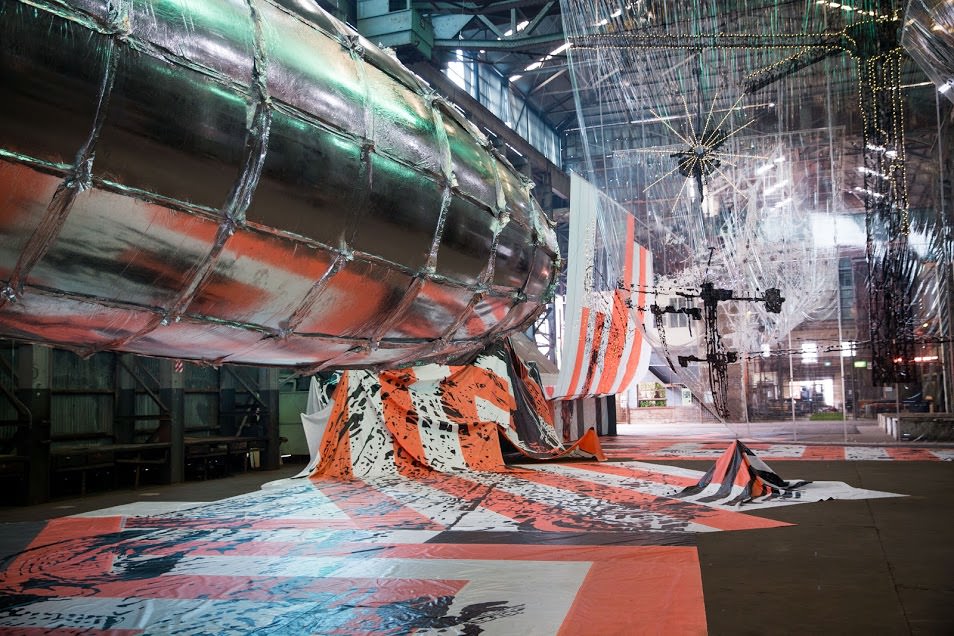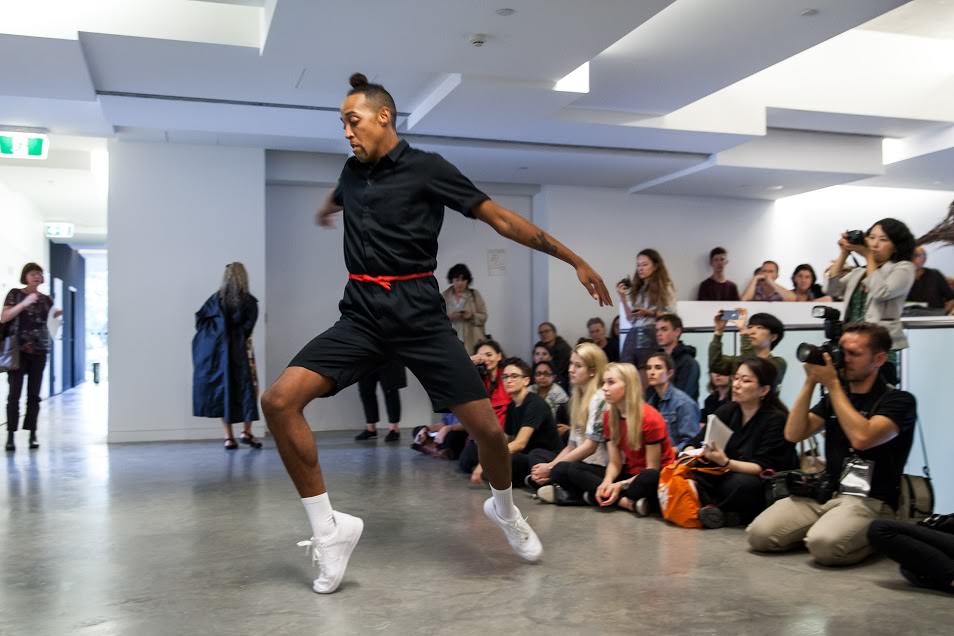The first time I visited Cockatoo Island, situated at the junction of the Parramatta and Lane Cove rivers in Sydney Harbor, the island existed as a relic to its illustrious past as a penal establishment, shipyard, and site of a reform school for girls. Apart from the few people wandering around the convict quarters and the campers settling in for their overnight Cockatoo Island “glamping” experience—where visitors can stay in prearranged tents with hot showers and communal cooking areas—the island stood as a quiet historical testament surrounded by the sailboats, luxury cruise lines, water ferries, and cargo ships that occupy the bustling waterways of Sydney Harbor. Upon my return a few weeks later, the island had been taken over by artists and curators who radically transformed the antiquated industrial factories and shipyards into the futuristic Embassy of the Real for the 20th Biennale of Sydney.
Before our exploration of the island, the attendees of the vernissage preview met outside the Museum of Contemporary Art Australia, located on the edge of Circular Quay and The Rocks, which was the first site of European settlement in Australia. Now home to popular cafés that serve locally sourced Aussie “brekky” or traditional fish and chips as well as weekend markets, The Rocks is yet another emblem of the convergence of Sydney’s past and present. Much like the striated sandstone cliffs that border the harbor, Sydney itself is a city of layers. From the untamed bush-walks of Neutral Bay and the popular coastal hikes around the surfers’ haven Bondi Beach to the trendy bars and restaurants of Surry Hills and Newtown, Sydney is the type of city that doesn’t play into just one image. While the East and West Coasts of the U.S. battle in a perpetual popularity contest, Sydney effortlessly combines New York’s cool and Los Angeles’s laid-back attitude. This dynamic approach holds true for the arts as well, with popular artists such as Daniel Boyd and Guan Wei addressing historically significant moments in a contemporary manner.

Lee Bul, Willing To Be Vulnerable, 2015–16, photo by Ben Symons, courtesy of the artist.
Perhaps one of the most well-known achievements of artistic innovation in Sydney, the Sydney Opera House stands just on the other side of Circular Quay opposite the Museum of Contemporary Art. In the rain-streaked windows of the water taxi whisking us away from the quay and toward Cockatoo Island loomed the sail-like configuration of the Opera House unaffected by this rather blustery morning. Designed by the Danish architect Jørn Utzon after he won the 1956 international design competition for the plan of the building, the Opera House is a triumph of late-modern architecture and a stage to an international roster of performing artists. Similarly, Cockatoo Island is also a site for the convergence of international art bound together through one shared location in Australia. This year’s biennale is split between six “Embassies of Thought,” which the artistic director, Dr. Stephanie Rosenthal, described upon our arrival on the island as “explicitly not related to colonial or imperial history, diplomatic missions, cultural and linguistic boundaries, or capitalistic power structures. Instead, they provide safe spaces for thinking.”
After our introduction, we were given maps of Cockatoo Island and set loose to explore the Embassy of the Real on our own terms. The Industrial Precinct’s rusting machinery provided an interesting arena for this embassy’s theme of exploring our perception of reality in an increasingly digitized world. I was utterly immersed within the clash of past, present, and future as I wandered through Lee Bul’s behemoth installation of orange tarps, metallic blimps, and a transparent film hot air balloon within the vast space of the industrial warehouse. Every corner I turned, I was met by yet another installation throwing the venue’s historic background into sharp relief. Korakrit Arunanondchai’s video installation included not only a large-screen projection, but also a viewing platform with blue and white dyed cushions that the audience approaches barefoot from a matching denim-covered runway. In the next room, William Forsythe’s labyrinth of pendulums hung from the towering ceiling, calming swinging as if to the ticking of a clock, counting off the seconds distancing us from the past and propelling us to the future.

Adam Linder, Some Proximity, 2014, photo by Ben Symons, courtesy the artist and Silberkuppe, Berlin.
On the Upper Island the convict quarters and guard shacks that were once actually inhabited by the prisoners and their overseers were now occupied by a very different residence. Bharti Kher’s seated statues lined up silently among their seats in the wooden housing structures, while Cevdet Erek’s sound installation rhythmically rebounded off the stone walls of the now-empty guard lookout. Alexis Teplin’s interdisciplinary performance art provided colorful backdrops and animated performances to the otherwise bleak convict quarters.
On Friday Cocaktoo Island transformed once again for the opening night party, where San Francisco’s gender nonconformist boychild, accompanied by live percussion, transformed into a cyborg while performing on Arunanondchai’s video installation stage. If the Embassy of the Real is the geographical manifestation of where reality and projections of the future collide, then boychild is the living incarnation. To think that only a few weeks ago at this very location I was reclining on a beach chair watching the sailboats glide by while sipping a cocktail from the Cockatoo Island Bar seemed utterly unfathomable; but then again, maybe that’s the point.
This article is published in Whitewall‘s summer 2016 Design Issue.








